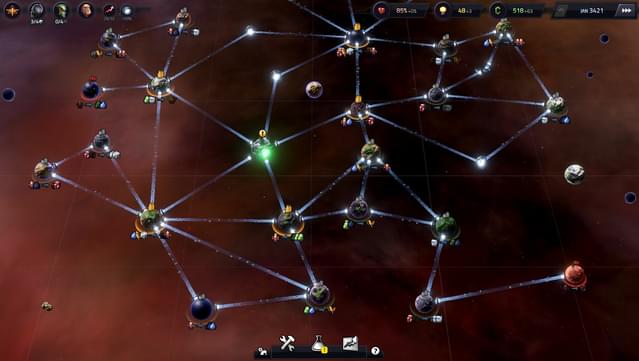


Each level might require one or two imports of the same or different types, and the output grows in magnitude or variety, depending on the type of planet and the production duo selected when the planet was colonized. Once the production schedule has been selected, it cannot be changed, and once a trade route has been established, it cannot be removed.Ĭlicking on a colonized planet will reveal a zoomed in view that lists the three stages of development. The biggest issue is that slipways cannot cross one another (again, unless you unlock certain tech), meaning that it’s of the utmost importance to understand a planetary neighborhood before you go connecting planets to grab the first attractive trade deal. Distance between planets is one these slipways can only extend so far without advanced research unlocked. This is the core of the game: colonizing planets and linking up products with consumers. In order to keep the planet happy, it needs to have it’s input material provided, and needs a place to ship it’s output material. These options takes the form of an input and an output. Your goal, then, is to colonize these planets by selecting a production schedule from either one or three options (the number of options depends on the planet type and size, it seems). Each probe will reveal either a planet, an asteroid, or a remnant of a long dead civilization. Each launch requires a certain amount of cash (because even black hole dwellers have to pay to play) at when the game starts cash is relatively scarce. To start, you can drag the mouse out from the center of the exposed area to launch a probe. A fog of war encircles the galaxy beyond that. You apparently live in the black hole at the center of this part of Existence, and are surrounded by shadowy and unexplored signals. These are also apparently tied to the seed value, and using the “?” button will generate new seeds.Ī game starts with a relatively empty galaxy view. Eventually, and I don’t know what triggers the unlock, you can active the “quirks” mode which can provide bonuses or debuffs to your progress. Each resulting system is built off a seed, and although the seed format makes randomly bashing the keyboard more difficult than in other seeded games (I am sad because I can’t use 8675309 seed for this game), you should be able to share a seed with another player and get the same game, allowing you to challenge your friends to an informal PBM competition. Although this allows you to select a “location” within the galaxy, I haven’t been able to figure out if there’s any benefit to picking one shade of nebula over another. Slip Relay is one of the best perks in the game. You can choose two perks from the six available while selecting the Council members, but the tech items have to be unlocked by earning and spending research points in the game. Each come with a tech tree and two perks. There are five races to choose from, and you can choose three.

The Campaign and Ranked Run require that you make it through a Standard Run with a 3 and 4 star rating respectively. There’s also Endless mode which doesn’t have the 25 year hard-stop, a Campaign mode, and a Ranked Run. There’s no other objective than to not ruin all of galactic civilization through gross incompetence. This mode gives you 25 in-game years to simply get as far as you can. At first, there’s only one mode: Standard Run. On the other hand, it has become my go-to game as of late because it’s easy to start playing, but difficult to stop.Įach game starts with the selection of a mode.
Slipways gog how to#
I’m not really sure how to classify this game, because on one hand if I were to describe it as a “mobile-esque” game I’d consider that to be pretty damning. Slipways is not a 4X game, despite what it might seem when you look at screenshots.


 0 kommentar(er)
0 kommentar(er)
